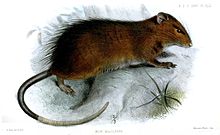
The black rat, also known as the roof rat, ship rat, or house rat, is a common long-tailed rodent of the stereotypical rat genus Rattus, in the subfamily Murinae. It likely originated in the Indian subcontinent, but is now found worldwide.

The brown rat, also known as the common rat, street rat, sewer rat, wharf rat, Hanover rat, Norway rat and Norwegian rat, is a widespread species of common rat. One of the largest muroids, it is a brown or grey rodent with a head and body length of up to 28 cm (11 in) long, and a tail slightly shorter than that. It weighs between 140 and 500 g. Thought to have originated in northern China and neighbouring areas, this rodent has now spread to all continents except Antarctica, and is the dominant rat in Europe and much of North America. With rare exceptions, the brown rat lives wherever humans live, particularly in urban areas.

Rattus is a genus of muroid rodents, all typically called rats. However, the term rat can also be applied to rodent species outside of this genus.

The bush rat or Australian bush rat is a small Australian nocturnal animal. It is an omnivore and one of the most common indigenous species of rat on the continent, found in many heathland areas of Victoria and New South Wales.
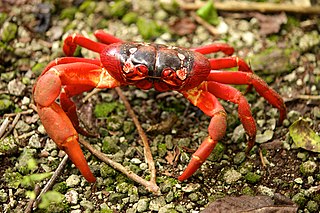
The Christmas Island red crab is a species of land crab that is endemic to Christmas Island and Cocos (Keeling) Islands in the Indian Ocean. Although restricted to a relatively small area, an estimated 43.7 million adult red crabs once lived on Christmas Island alone, but the accidental introduction of the yellow crazy ant is believed to have killed about 10–15 million of these in recent years. Christmas Island red crabs make an annual mass migration to the sea to lay their eggs in the ocean. Although its population is under great assault by the ants, as of 2020 the red crab had not been assessed by the International Union for Conservation of Nature (IUCN) and it was not listed on their Red List. The crab's annual mass migration to the sea for spawning is described as an "epic" event. Millions emerge at the same time, halting road traffic and covering the ground in a thick carpet of crabs.

The bulldog rat is an extinct species of rat formerly endemic to Christmas Island in the Indian Ocean. It was one of two rats endemic to Christmas Island, alongside Maclear's rat.

Bandicota is a genus of rodents from Asia known as the bandicoot rats. Their common name and genus name are derived from the Telugu language word pandikokku (పందికొక్కు). DNA studies have found the group to be a monophyletic clade sister to the radiation of Molucca and Australian Rattus species as part of the paraphyletic Rattussensu lato.

The heath mouse is a species of mouse in the subfamily Murinae, the Old World rats and mice, found in Australia.

The Christmas boobook, also known more specifically as the Christmas Island hawk-owl, is a species of owl in the family Strigidae.

The Christmas Island shrew, also known as the Christmas Island musk-shrew is an extremely rare or possibly extinct shrew from Christmas Island. It was variously placed as subspecies of the Asian gray shrew or the Southeast Asian shrew, but morphological differences and the large distance between the species indicate that it is an entirely distinct species.
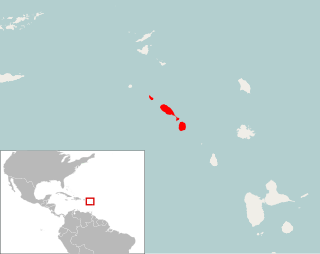
Pennatomys nivalis is an extinct oryzomyine rodent from the islands of Sint Eustatius, Saint Kitts, and Nevis in the Lesser Antilles. The only species in the genus Pennatomys, it is known from skeletal remains found in Amerindian archeological sites on all three islands, with dates ranging from 790–520 BCE to 900–1200 CE. No live specimens are known, but there are several historical records of rodents from Saint Kitts and Nevis that could conceivably refer to Pennatomys. The animal apparently belongs to a group within the tribe Oryzomyini that includes many other island-dwelling species.
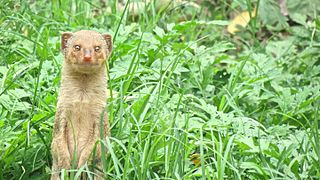
The small Indian mongoose is a mongoose species native to Iraq and northern South Asia; it has also been introduced to many regions of the world, such as several Caribbean and Pacific islands.

Trypanosoma lewisi is a globally distributed parasite of Rattus species and other rodents such as mice, and of kangaroo rats in America. Among these host species were two endemic species of rats: Rattus macleari and Rattus nativitatis. Both are now believed to be extinct. It is not very clear whether or not the same parasite infected both species. However, both parasites are very similar. The northern rat flea acts as the vector for the parasite, harboring the epimastigote stage in its midgut. The trypomastigote is the stage that is present in the main host, the rodent. The epimastigote form attaches itself to the rectum of the insect using its flagella to burrow through the rectal walls. The parasites also appear in the flea's feces. Ingestion of either the flea or its feces during grooming infects the host rodent with the parasites. T. lewisi is normally non-pathogenic but is known to have produced fatal infections in rats.
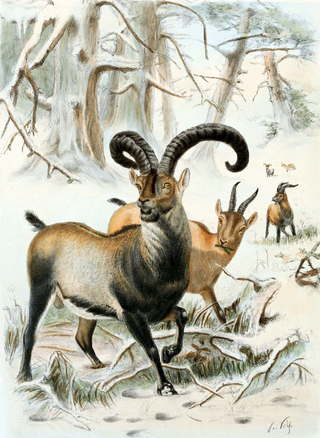
De-extinction is the process of generating an organism that either resembles or is an extinct species. There are several ways to carry out the process of de-extinction. Cloning is the most widely proposed method, although genome editing and selective breeding have also been considered. Similar techniques have been applied to certain endangered species, in hopes to boost their genetic diversity. The only method of the three that would provide an animal with the same genetic identity is cloning. There are benefits and malefits to the process of de-extinction ranging from technological advancements to ethical issues.
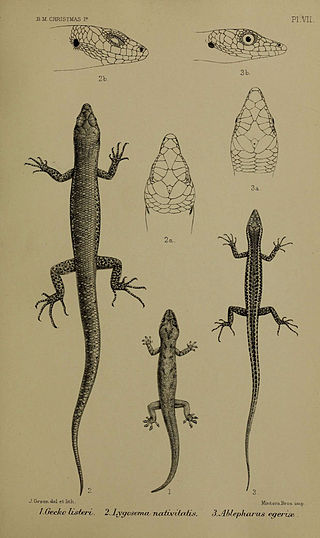
The Christmas Island forest skink, also known as the Christmas Island whiptail skink, is a species of skink formerly endemic to Australia's Christmas Island. As of 2017, it is listed as extinct on the IUCN Red List. The last known forest skink, a captive individual named Gump, died on 31 May 2014.

The Gau iguana is a species of iguana endemic to Gau Island in the Fijian archipelago. It mostly lives in the well-preserved upland forests of the island, with smaller populations in the degraded coastal forests. It can be distinguished from other South Pacific iguanas by the male's distinctive color pattern and solid green throat. It is also the smallest of all South Pacific iguanas, being about 13% smaller than the third smallest species and 40% smaller than the largest extant species.

The wildlife of Christmas Island is composed of the flora and fauna of this isolated island in the tropical Indian Ocean. Christmas Island is the summit plateau of an underwater volcano. It is mostly clad in tropical rainforest and has karst, cliffs, wetlands, coasts and sea. It is a small island with a land area of 135 km2 (52 sq mi), 63% of which has been declared a National park. Most of the rainforest remains intact and supports a large range of endemic species of animals and plants.

Rattini is a very large, diverse tribe of muroid rodents in the subfamily Murinae. They are found throughout Asia and Australasia, with a few species ranging into Europe and northern Africa. The most well-known members of this group are the true rats, several species of which have been introduced worldwide.
Megalomys camerhogne is an extinct species of giant rice rat from Grenada in the genus Megalomys. It is known only from Pearls, an archeological site in Saint Andrew dated to about 400 to 1650 CE. Though there are no historical records of its occurrence on Grenada, it is likely that the species survived until European contact in the 16th century. Its extinction may be related to competition with black rats or to predation by the small Indian mongoose, which was introduced to Grenada in the 1870s.
